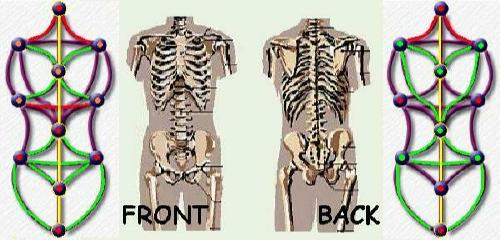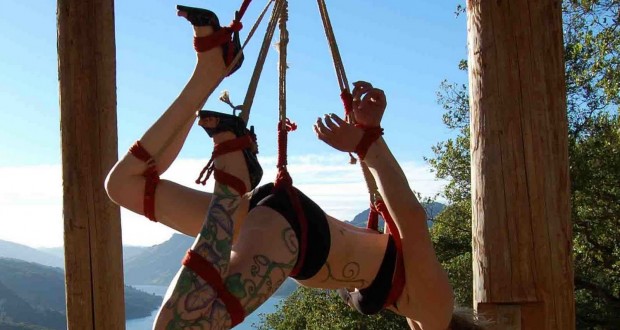by Hans Meijer,
Featured Photo by Lew Rubens.

The above picture is what should always be in the forefront of your mind, when working with suspensions. The outer graphics represent the general situation of what the bondage should look like and where support should be, the inner ones of course are the human skeleton, front and back side. People with a spiritual background will easily recognize the Tree of Life in the schematic representation. And indeed it is. The Tree of Life originates from the Middle East (from the days well before Christ) and it is a philosophical approach to life, a representation of mysticism as well as a mathematic formula to calculate energy (weight or gravity pull is energy) distribution. And yes, it does follow the contours of the human body rather nicely – no surprise.
The yellow line
The yellow line (in the middle) although in the position of the spine, does not represent the spinal column, but two other things: the main energy line between the universe (usually above you) and the planet (usually below you) as it flows through the body and a boundary. The boundary is the boundary between the left and right half of the body. The two, although in many ways alike, are significantly different from each other, in brain half, in placement of organs, in a spiritual way, in an erotic way and in a physiological way.
The points on this line (at this point disregarding their colors) represent chakras, in other words main Ki energy entry/exit points, i.e. your main pressure points. Observed from the front, the yellow line represents the Conception Vessel (one of the two main Ki-meridians (from a Shibari point of view). Observed from the back it represents the Governing Vessel (the other main Ki-meridian, again from a Shibari point of view).
The green lines
The green lines represent the gravity pull, i.e. the way gravity pulls on the body (usually we identify “gravity pull” as “weight”, but gravity pull is actually a more accurate description and more useful in a Shibari suspension context). As you can see, this is usually also where ropes are being placed, and not only in suspension situations.
The green dots on this green line (back view only) represent areas that can be supported safely, without any direct other consequences (either from a Shiatsu or safety point of view).
The red lines
The red lines represent areas, where any sort of pressure should be avoided at all times during suspension (this of course includes using them for support purposes). These are the neck and the diaphragm (on the front side of the body). Dots have no relevance to these lines.
The purple lines
The purple lines represent the area in the body, where all life supporting organs are situated, separated into two different halves (upper and lower) by the diaphragm. As opposed to another vital organ (the brain) the organs are not protected by a solid shield (as the skull is). The upper half is largely (but not entirely) protected by a flexible casing – the rib cage, shoulders and shoulder blades. The lower half is only partially protected by the pelvic bone structure, but most of it is not protected by any bone structure. This is a deliberate design, they are supposed to be in a very flexible environment. Dots on these lines have no specific relevance.
From a purely physiological point of view we have already explained that you will always need to bear in mind that the H-structure, composed by the shoulders, spine and hips, should be regarded as ONE structure. In simple terms, from a suspension point of view we can divide the body into six different, integrated structure groups: the two arms, the two legs, the head and neck and the central H (or torso if you like). Some seventy percent (on average) of your body weight is in the area between the neck and the bottom of the buttocks.
Seventy percent of the body weight is in the central H, so 70 percent of the suspension support should either be there or directly relevant to that. If you get that right, you get most of your suspension right!
From an energy point of view, much more activity is going on there. If you look at the body as an industrial park, Silicon Valley is largely located in the head (the brain), while the vast majority of the companies – that make Silicon Valley work – are located in the torso (the central H). That is where energy is taken in, processed, distributed, the water and sewage companies are located as well as almost all other facilitating companies. You entire nerve system runs through it, so does youir bloodstream, airflow, nutrients and Ki energy. No wonder the vast majority of the Shiatsu Tsubo are also located on the central H, hence, you are also likely to interfere with the Ki energy, the moment you touch it, let alone put major pressure on it through suspension.
In many ways the human body has a top-down structure. Information is processed in the top part, hence all information needs to go up first to be identified, interpreted and processed, before it can be distributed again to the relevant recipients (most of that means it has to go down again). The breathing system works top-down, so does the intake of food. Waste largely goes down and the vast majority of the blood circulation is going top-down or vice versa and so do you Ki-energy flows. All this is a direct result of gravity pull. Meaning that as soon as you start to interfere with gravity pull, you will start to interfere with all the above systems at the same time. You are jungling with many, many balls!
And there is another thing to consider. The relatively tiny ankle bones (compared to something as massive as a hipbone or a shoulder blade) are designed to carry our entire body weight. Place 200 pounds on an ankle and it can carry it, probably quite easily. Place the same 200 pounds on a rib and it is likely to break. What is true for the bonestructure is also true for our muscular system. If your bodyweight is 200 pounds, your legs will have little problem to carry it around and bring it to whereever it wants to go. Now use your (also very strong) arms and you will suddenly have a lot more trouble to pull all that weight up. You can stand a lot longer than you can hang from your arms, even if you work out on a daily basis.
While all this seems terribly obvious, when it comes to suspension it is actually not. The reason – you need to think differently.
The essence of suspension is not to know where the weight is, but to know where it wants to go!
Actually, you need to understand weight as a trajectory. In other words: where is it (starting point), where does it want to go and what path will it follow. While the body remains stationary, the weight is actually moving! So, for change, what you see is NOT what you get.
The river suddenly flows sideways
Remember how, in “the Beginning” we talked about The River? The combination of your energy flows? And how this river largely flows top down, from the head to the soles? Well, with the exception of a few, in almost all Shibari suspension positions it no longer will. The River might suddenly flow sideways, or even UPHILL! That depens on the position you have chosen and on the energy containment fields, you have created through other, additional bondages or through the suspension ropes themselves.
Energy entry and exit points change. In fact, the whole map suddenly changes. Of course, all of that is done purposely! But it is important that you understand what purpose you are after.
What we are actually talking about is a complex set of management levels:
1. Weight/gravity management
2. Energy management
3. Comfort/discomfort management
4. Reality perception management
The primary goal of suspension is a different level or awareness!
Some people, when talking about spirituality, trance or similar subjects, speak of a “higher level of awareness” (or consciousness). We like to speak of different levels of awareness. Our mind is capable of different states of awareness. The two you are most familiar with are being awake and (more or less) aware of the reality of your surroundings and sleeping and being aware of your subconsciousness (dreaming). In fact, you could identify being drunk or otherwise intoxicated as a different state of awareness and driving your car as a different state of awareness. There are many other states.
The most obvious thing about states of awareness is that almost all of them require a specific environment. Being aware of your subconsciousness (dreaming) is probably not a good idea while you are driving your car or operating a chain saw. Being drunk is quite okay, as long as you exclude yourself from certain other realities, such as managing a company or having tea with your mother in law. Human beings can multi task, as long as the multitasking is done within one and the same reality. Multitasking different realities does not work and the prevailing reality will take over. Need a few examples? If you feel sick you’re usually very quickly incapable to do many other things. Being sick is a reality and that reality requires (compels you into) in different mindset – a different state of awareness, excluding most others. A mother giving birth at that moment could not care less about the mortgage payments, regardless how urgent they are. Different reality, different state of awareness, different priorities. Problems at home will very quickly interfere with your ability to fully function at work. Different reality, different state of awareness, different priorities.
Most of these things are very hard if not impossible to control. Someone who is angry is usually not very open to logical explanations, even if he or she wanted to. All that is, is that the entity we call a body (the integrated concept of body, mind and spirit) responds to other energies. Anger is created by something outside that entity (such as another person or a situation). Problems at home are not a physical part of that entity. Actually – logical or not – our first response is almost always to an “outside entity”. If the bank does not honor your check, your first response will almost always be “the bank is being difficult” (not logical, but still an understandable reaction). All these are just a few examples, there are many.
Energies and physiological activities influence each other and together create your state of awareness. Fear can make you feel sick. Love can make you cry. The combination of both and their interaction creates your state of awareness that, subsequently, determines your priorities.
It is not (just) the mind that is capable of many things, it is the entire entity of body, mind and spirit. That is a holistic approach (or a tantric one if you like). Everyone is capable of making that entity work for him of her. At some point all of us can do things we normally are not capable of (people rise above themselves or above the occasion). Some people can do that consciously and deliberately. Athletes for example. And ….. in Shibari we are doing exactly that. We are deliberately influencing our reality – temporarily changing our reality – in order to free our entity of other realities and open it up for impulses, that normally would not come through. When working with suspensions, we amplify this capability.
The above four levels of management allow us to alter the state of the body-mind-spirit entity and as a result alter our state of awareness.




